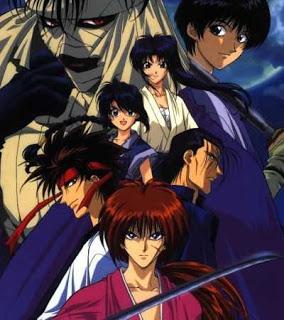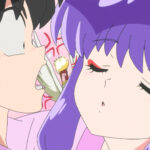In the effort to keep myself from becoming too distraught by the events occurring in Northeast Japan, I’ve been revisiting an old favorite – and when I say “old favorite” I mean it. Rurouni Kenshin was one of the very first anime I ever watched, and was the very first manga series I ever read start to finish.
To be truthful I’ve been doing a rewatch of the anime for a few weeks, so I was well into it when the disaster began. But I’ve found strange comfort in this old favorite, and it occurs to me that many more recent converts to anime and manga may not have actually watched the series or read the manga – though as many iterations as there are, it’s hard to imagine they wouldn’t be familiar with the property. There’s the TV, a movie, two OVAs, the manga of course, and numerous game options. For my money the Samurai X OVAs are an interesting distraction – by all means watch them if you like, but after you’ve either read the manga or watched the series. They’re not canon and don’t represent the vision of creator Nobuhiro Watsuki in any way, shape or form. They’re gorgeously animated and technically brilliant – but for me, betray the spirit of Rurouni Kenshin. YMMV, of course.
 Specifically, I want to touch briefly on the “Kyoto Arc” of the TV series – sometimes called the Shishio Arc, or Legend of Kyoto. It constitutes the second season of the TV series and represents, for me, the pinnacle of shounen writing. The first season of the anime is wholly worthwhile and should be watched before the Kyoto Arc – it does a great job of introducing the major characters and most of the short arcs are quite good. There are four main characters here – young dojo owner Kamiya Kaorou, orphaned samurai’s son Yahiko Myojin, street tough Sagara Sanosuke and, most importantly, Kenshin Himura – the “Rurouni”, or wandering samurai. The major supporting characters are excellent. Watsuki has stated that Yahiko is his own avatar in the series – a kid who wants to be strong. You’ve seen shounen characters like Yahiko many times, but very few are as complex and likable. He’s a model of courage and dedication without being unnaturally mature about it. Kaorou is a good love interest for Kenshin – she’s a strong woman but still only 17 and highly emotional, and she provides Kenshin the anchor he so desperately needed in his life. Sanosuke is a mixed bag in S1, often acting rash to the point of stupidity and being used too often for comic relief. But it’s in S2 – ironically, as he’s absent for long stretches of it – where he really matures and stretches out as a character.
Specifically, I want to touch briefly on the “Kyoto Arc” of the TV series – sometimes called the Shishio Arc, or Legend of Kyoto. It constitutes the second season of the TV series and represents, for me, the pinnacle of shounen writing. The first season of the anime is wholly worthwhile and should be watched before the Kyoto Arc – it does a great job of introducing the major characters and most of the short arcs are quite good. There are four main characters here – young dojo owner Kamiya Kaorou, orphaned samurai’s son Yahiko Myojin, street tough Sagara Sanosuke and, most importantly, Kenshin Himura – the “Rurouni”, or wandering samurai. The major supporting characters are excellent. Watsuki has stated that Yahiko is his own avatar in the series – a kid who wants to be strong. You’ve seen shounen characters like Yahiko many times, but very few are as complex and likable. He’s a model of courage and dedication without being unnaturally mature about it. Kaorou is a good love interest for Kenshin – she’s a strong woman but still only 17 and highly emotional, and she provides Kenshin the anchor he so desperately needed in his life. Sanosuke is a mixed bag in S1, often acting rash to the point of stupidity and being used too often for comic relief. But it’s in S2 – ironically, as he’s absent for long stretches of it – where he really matures and stretches out as a character.
But of course, this is a series about the man in the title – and it rides on his shoulders. In many ways I consider Kenshin to be the perfect protagonist, in much the same way I think of Jean Valjean as being so. He’s an unassuming figure – slight, quiet, almost womanish (in fact, he is voiced be a female seiyuu) but bears the weight of a terrible personal history. He was a Battousai – Manslayer – fighting on the side of the Imperialists during the Boshin War – the great civil war of 1868-69 that saw the imperialist forces fighting those loyal to the ruling Tokugawa Shogunate. Their most famous supporters were the Shinsengumi – well-known in anime and manga circles and Kenshin’s arch-enemy. The Imperialists won of course, and the Meiji Government was formed – but Kenshin bore a terrible guilt for all the killing he had done. He resolved to live a life of peace, protecting the helpless, and never killing again. Much of S1, though conventional, does a nice job of setting up that scenario.
 It’s in S2, though, that the series goes from being a very good shounen to something more, something with a touch of poetry to it, and a true epic. The entire season is one arc, dedicated to the battle between Kenshin and the man who succeeded him as Battousai, Makoto Shishio. The plotting of this arc is a thing of beauty – starting with the return of Kenshin’s great rival, Shinsengumi Captain Saito Hajime (again, a familiar name to manga fans). Saito, now working as a secret policeman for his former enemies, is recruited to try and get Kenshin to fight Shishio. Shishio, no longer useful to the Meiji Government after the war and indeed dangerous, was betrayed and thought dead – but he survived, terribly burned and filled with hatred. He rises like a phoenix from his own ashes and raises a terrible army – the Juppongatana, or “Ten Swords” – in a remote hideout outside Kyoto. Acting as a sort of terrorist organization, he aims to destroy the government both as an act of revenge on to impose his “only the strong survive” will on the country. This ghost from Kenshin’s past means an end to his idyllic life at the Kamiya Dojo, acting as a sort of surrogate father to Yahiko and chaste partner to Kaorou.
It’s in S2, though, that the series goes from being a very good shounen to something more, something with a touch of poetry to it, and a true epic. The entire season is one arc, dedicated to the battle between Kenshin and the man who succeeded him as Battousai, Makoto Shishio. The plotting of this arc is a thing of beauty – starting with the return of Kenshin’s great rival, Shinsengumi Captain Saito Hajime (again, a familiar name to manga fans). Saito, now working as a secret policeman for his former enemies, is recruited to try and get Kenshin to fight Shishio. Shishio, no longer useful to the Meiji Government after the war and indeed dangerous, was betrayed and thought dead – but he survived, terribly burned and filled with hatred. He rises like a phoenix from his own ashes and raises a terrible army – the Juppongatana, or “Ten Swords” – in a remote hideout outside Kyoto. Acting as a sort of terrorist organization, he aims to destroy the government both as an act of revenge on to impose his “only the strong survive” will on the country. This ghost from Kenshin’s past means an end to his idyllic life at the Kamiya Dojo, acting as a sort of surrogate father to Yahiko and chaste partner to Kaorou.
The entire 35-episode season fits together like an intricate jigsaw puzzle – starting with Saito’s appearance in Tokyo, then the journey to Kyoto, then the events there. Entire runs of episodes feature the complete absence of the main characters of S1 – including Kenshin himself – as the side arcs are given ample time to play out. New characters – Aoshi, Misao, the entire Aoiya Group, even the Juppongatana themselves – are fleshed out as fully-formed characters. In particular, the story of Anji the Monk – the most sympathetic of the Juppongatana – is powerful. The episode exploring his past is one of the best and most moving of the season. Shishio himself is a wonderful villain – generally quiet and calm, but extraordinarily menacing – he’s little involved in the fighting for most of the season but that makes the moment when he finally takes up the sword that much more powerful. And from episode 50 on you get one of the very best OP/ED songs from any anime – “It’s Gonna Rain”.
I can’t recommend this season highly enough – if you’re worried about it being dated, don’t be. It looks remarkably good for a 15 year-old series. I will warn you, though, that you’re best served by abandoning the anime at the close of this arc. Unfortunately the anime abandons the manga at this point and embarks on a season of anime-only episodes, most of which are frankly mediocre. But the good news is, the manga – one of the very best you’ll ever read – continues on with another extended arc, the “Jinchu” (Revenge) Arc. It’s almost as good as the Kyoto Arc and involves another figure from Kenshin’s past, this one even farther back. Kenshin fans have dreamed for years about an adaptation of this arc – and given that this is the 15th Anniversary of RK, with a new live-action planned for next year and a new fighting game released this March – there’s always hope that the continued interest in the property might mean an anime adaptation. It’s a long-shot, but I haven’t given up hope.







Anonymous
April 17, 2011 at 2:31 pm1. You should watch the show in mediablasters english dub; it is WAY better.
2. Shishio did not succeed Kenshin as Battousai. Battousau is a name exclusive to Kenshin. He succeeded him as the "assassin in the shadows" not as the Battousai.
3. Yes I really hope they continue it to the Jinchu Arc. There is even talk of a complete remake and reanimation but I'd prefer a continuation.
Rurouni Kenshin FTW!!
admin
April 17, 2011 at 5:13 pmAmong Shishio's many aliases is "The Second Battousai", so I'll stick to my guns on this one…
I'd be fine with a complete remake – that worked fine with FMA. But honestly, I only really need Jinchu. I think they did the first two seasons pretty much right, and the Kyoto Arc almost perfectly.
I have watched the MB dub, and it is better. But for me, there probably isn't a single dub that can equal the original Japanese track for any series (FLCL and Tenchi Muyo come pretty close). If I love the original, I don't generally see much need to watch the dubbed version beyond an ep or two for comparison. Of course a good dub is always better than a bad one…